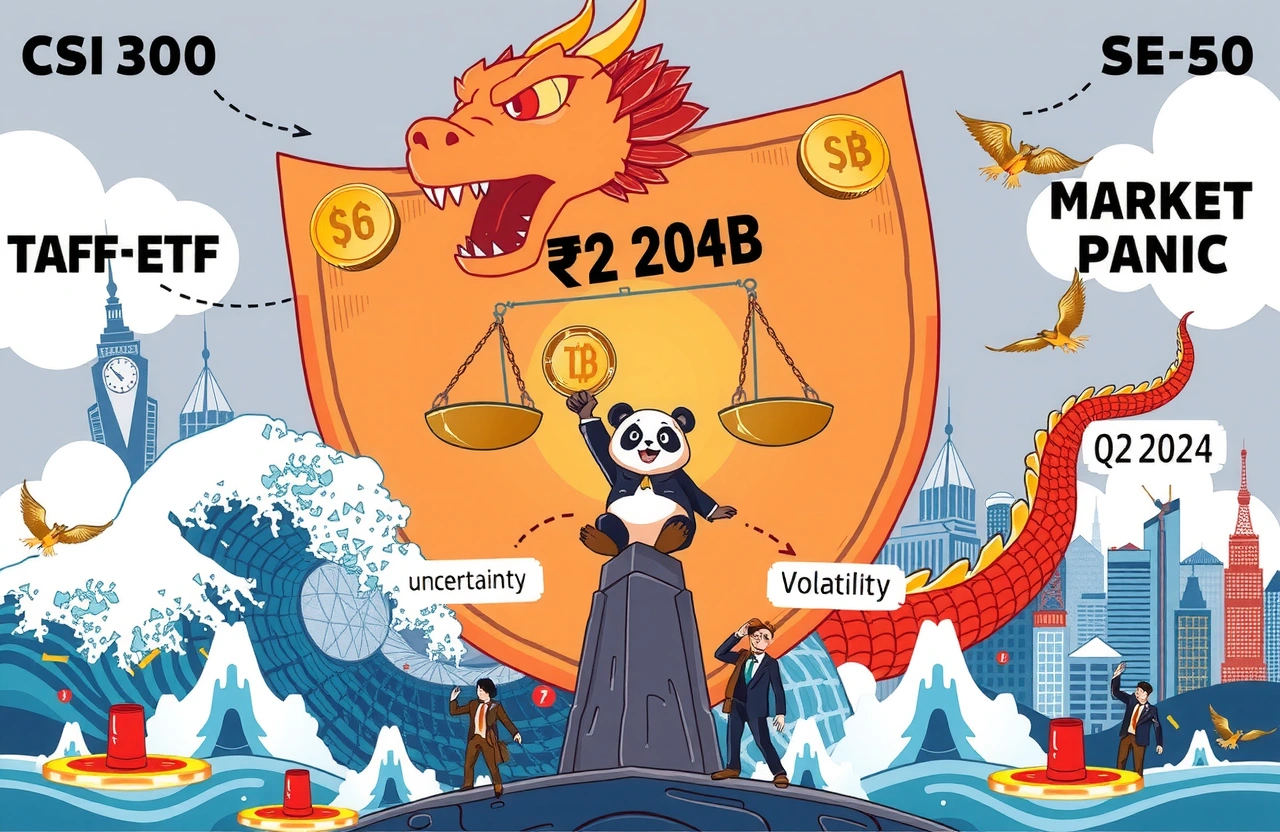Market Rescue Mission: Huijin’s Massive Intervention
A bombshell revelation emerged as China’s major exchange-traded funds (ETFs) disclosed their second-quarter holdings. The reports confirm Central Huijin Investment Ltd., often dubbed China’s ‘national team,’ executed history’s largest single-month market stabilization operation in April 2024. As tariff tensions sparked panic selling, Huijin deployed over ¥210 billion ($290 billion) into at least eight broad-based ETFs – an unprecedented move that exemplifies Central Huijin’s market stabilization capabilities.
Key findings from Q2 disclosures:
– Central Huijin deployed emergency capital equivalent to Iceland’s GDP during market rout
– Targeted core indices including CSI 300, SSE 50, and CSI 1000 ETFs
– Stabilization efforts helped Shanghai Composite gain 3 consecutive monthly closes
– Strategy underscores Huijin’s evolution into formal market stabilization force
Breaking Down The ¥210 Billion Lifeline
Precision Targeting Strategy
Huijin executed strategic precision through centralized purchasing of key indices. Analysis of fund manager disclosures reveals painstaking coordination across China’s largest ETFs, demonstrating Central Huijin’s market stabilization approach directly countered panic selling pressure points.
ETF Purchase Breakdown
Evidence confirms massive injections:
CSI 300 Dominance:
– Huatai-Pinebridge CSI 300 ETF: 108.74B shares (¥400B allocation)
– ChinaAMC CSI 300 ETF: 92.88B shares (¥350B injection)
– E Fund CSI 300 ETF: 84.29B shares (¥320B deployment)
– Harvest CSI 300 ETF: 55.4B shares (¥200B commitment)
Complementary Index Support:
– ChinaAMC SSE 50 ETF: 81.83B shares (¥220B support)
– Southern S&P 500 ETF: 33.66B shares (¥190B infusion)
– Southern CSI 1000 ETF: 56.55B shares (¥130B allocation)
– Huaan SSE 180 ETF: 52.32B shares (¥180B injection)
The Stabilization Blueprint in Action
The April intervention unfolded with military precision across critical dates. On April 7, Huijin coordinated with China Reform Holdings Corp and China State-owned Capital Venture Capital Fund in simultaneous announcements. The next morning, Huijin executives publicly embraced their ‘quasi-stabilization fund’ identity – a watershed admission confirming market stabilization institutionalization.
The People’s Bank of China cemented this positioning by pledging unlimited liquidity support: ‘We stand ready to provide Central Huijin with sufficient relending support to resolutely maintain stable capital market operations.’ This coordinated response exemplifies Central Huijin’s market stabilization protocol activation.
Historical Precedents and Evolution
Patterns of Intervention
Shenwan Hongyuan chief strategist Fu Jingtao identifies key Central Huijin stabilization milestones:
– October 2023: Simultaneous bank stock and ETF purchases ended valuation collapse
– February 2024: Expanded ETF coverage to growth sectors, sparking Spring rally
– April 2024: Record-fast response to external tariff shocks
This repeated success cements Huijin’s reputation as China’s market stabilization backbone.
Operational Transformation
2024 marks Huijin’s transition from reactive rescuer to proactive guardian. April’s announcement confirmed systematic enhancements:
– Balanced ETF style allocation beyond traditional blue-chips
– Permanent liquidity channels from central bank
– Institutionalized coordination protocol with SASAC entities
Market Impact Assessment
The effectiveness of Central Huijin’s market stabilization surfaced immediately:
– April 8 panic selling abruptly reversed despite tariff headlines
– CSI 300 volatility plunged 38% within 72 hours of intervention
– Short-selling volume collapsed 53% week-over-week
– Retail trading participation surged ¥89B in subsequent sessions
Three-month indicators confirm durable stabilization – Shanghai Composite accumulated 10.2% gains through July 18, hitting yearly closing highs despite global uncertainty.
Global Significance of Stabilization Model
As sovereign wealth funds globally monitor China’s stabilization framework, key innovations emerge:
– Speed-to-market deployment surpassing Bank of Japan ETF programs
– Precision targeting absent in U.S. Exchange Stabilization Fund operations
– Integration of verbal guidance with capital deployment
The People’s Bank of China thesis – combining monetary backstops with equity injections – provides novel crisis response blueprint.
Path Forward
Central Huijin executives emphasize: ‘We possess sufficient confidence and capacity to resolutely maintain market stability.’ This manifests through dual commitments:
Operational Readiness:
– Enhanced monitoring for ‘timely and decisive intervention’ opportunities
– Permanent standing capital allocation authority
Strategic Portfolio Development:
– Continued diversification across market capitalizations
– Algorithmic trading integration for precision deployments
– Counter-cyclical position building during calms
The Q2 reports provide irrefutable proof – Central Huijin’s market stabilization apparatus stands as China’s most potent financial defense mechanism. Investors should monitor ETF quarterly disclosures as reliable gauges of stabilization positioning, while policymakers globally examine this unprecedented market intervention architecture.




